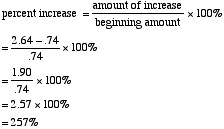
EXAMPLE 3.1.11
(The information in this example is factual, according to the Workers Rights Council.)
1. In a sweatshop in El Salvador, a seamstress is paid 74¢ for the labor required to sew one Liz Claiborne jacket (retail price: $198). If she were to be paid a "living wage," her pay would for that job would increase to $2.64. Find the percent increase in her pay if this were to happen.
SOLUTION

2. Referring to the information in Part 1:
Suppose that the seamstress' pay is increased so that she receives a "living wage," and suppose that the entire cost of this is passed on to the consumer. Find the percent increase in the retail cost of the jacket.
SOLUTION
If the seamstress' pay is increased to the living wage rate, then according to the previous calculation the amount of increase would be $1.90. If the entire increase is passed along through an increase in the price of the jacket, then the jacket's price would increase by $1.90. The beginning price for the jacket is $198, so the percent increase in the jacket's price would be as follows:

Note that this is .96%, not 96%. This is approximately 1%. Thus, a 1% increase in the price of the jacket could produce a 257% increase in the seamstress' wage.